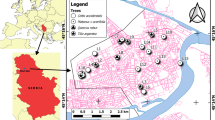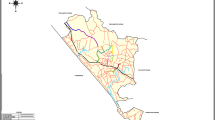Abstract
Plants in urban territories assume a fundamental job to purify the contamination in human conditions. Quickly developing biomass plants, for example, Salix species, are promising for use in phytoremediation of defiled land. It is realized that substantial metals are taken up and translocated by plants to various degrees. The section portrays the decision of eco-accommodating Salix alba species and their correct situation in the urban condition to defeat the contamination issues. White willow imitations can aggregate generous measures of Cd and Zn in the over-the-ground biomass and have along these lines been tried for phytoextraction of decently polluted soils. This section likewise audits the potential for the phytoremediation of substantial metal-defiled land by the Salix alba. The perspectives from various examinations on Salix alba have been utilized to exhibit the limit and plausibility of utilizing it in phytoextraction. Consequently, to augment phytoextraction productivity, it is critical to choose a quickly developing and high biomass plant with high take-up of substantial metals, which is additionally perfect with motorized development systems and neighborhood climate conditions.
Access this chapter
Tax calculation will be finalised at checkout
Purchases are for personal use only
Similar content being viewed by others
References
Aktaruzzaman M, Fakhruddin ANM, Chowdhury MAZ, Fardous Z, Alam MK (2013) Accumulation of heavy metals in soil and their transfer to leafy vegetables in the region of Dhaka Aricha highway, Savar, Bangladesh. Pak J Biol Sci 16(7):332–338
Atafar Z, Mesdaghinia A, Nouri J, Homaee M, Yunesian M (2010) Effect of fertilizer application on soil heavy metal concentration. Environ Monit Assess 160(1–4):83–89
Atagana HI (2011) Bioremediation of co-contamination of crude oil and heavy metals in soil by phytoremediation using Chromolaena odorata (L.)King & HE Robinson. Water Air Soil Pollut 215:261–271
Baker AJM, McGrath SP, Sidoli CMD, Reeves RD (1994) The possibility of in situ heavy metal decontamination of polluted soils using crops of metal-accumulating plants. Resour Conserv Recyl 11:41–49
Berndes G, Fredrikson F, Borjesson P (2004) Cadmium accumulation and Salix-based phytoextraction on arable land in Sweden. Agric Ecosyst Environ 103:20–23
Bissonnette L, St-Arnaud M, Labrecque M (2010) Phytoextraction of heavy metals by two Salicaceae clones in symbiosis with arbuscular mycorrhizal fungi during the second year of a field trial. Plant Soil 332:55–67. https://doi.org/10.1007/s11104-009-0273-x
Brieger G, Wells JR, Hunter RD (1992) Content in fly ash ecosystem. Water Air Soil Pollut 63:87–103
Cloutier HB, Turmel MC, Mercier C, Courchesne F (2014) The sequestration of trace elements by willow (Salix purpurea)—which soil properties favor uptake and accumulation. Environ Sci Pollut Res 21(6):4759–4771
Cooper EM, Sims JT, Cunningham JW, Berti WR (1999) Chelate-assisted phytoextraction of lead from contaminated soils. J Environ Qual 28:1709–1719
Cunningham SD, Owen DW (1996) Promises and prospects of phytoremediation. Plant Physiol 110(3):715–719
Das P, Samantaray S, Rout GR (1997) Studies on cadmium toxicity in plants: a review. Environ Pollut 98(1):29–36
Dickinson NM (2000) Strategies for sustainable woodland on contaminated soils. Chemosphere 41:259–263
Gerhardt KE, Huang XD, Glick BR, Greenberg BM (2009) Phytoremediation and rhizoremediation of organic soil contaminants: potential and challenges. Plant Sci 176:20–30
Goyal P, Sharma P, Srivastava S, Srivastava MM (2008) Saraca indica leaf powder for decontamination of Pb: removal, recovery, adsorbent characterization and equilibrium modelling. Int J Environ SciTech 5(1):27–34
Greger M, Landberg T (1999) Use of willow in phytoextraction. Int J Phytoremediation 1:115–123
Hammer D, Kayser A, Keller C (2003) Phytoextraction of Cd and Zn with Salix viminalis in field trials. Soil Use Manag 19:187–192
Hazrat A, Khan E, Anwar SM (2013) Phytoremediation of heavy metal concepts and applications. Chemosphere 91-7:869–881
Jadia CD, Fulekar MH (2009) Phytoremediation of heavy metals: recent techniques. Afr J Biotechnol 8:921–928
Kocik A, Truchan M, Rozen A (2007) Application of willows (Salix viminalis) and earthworms (Eisenia fetida) in sewage sludge treatment. Eur J Soil Biol 43:327–331
Laureysens I, Blust R, De Temmerman L, Lemmens C, Ceulemans R (2004) Clonal variation in heavy metal accumulation and biomass production in a poplar coppice culture: I. seasonal variation in leaf, wood and bark concentrations. Environ Pollut 131:485–494
Ledin S (1998) Environmental consequences when growing short rotation forest in Sweden. Biomass Bioenergy 15(1):49–55
Lovley DR, Coates JD (1997) Bioremediation of metal contamination. Environ Biotechnol 8:285–289
Maria D, SusannaRAR KM, Sessitsch A, Wenzel WW, Gorfer M, Strauss J, Puschenreiter M (2011) Interactions between accumulation of trace elements and macronutrients in Salix caprea after inoculation with Rhizosphere microorganisms. Chemosphere 84(9):1256–1261
Marmiroli M, Pietrini F, Maestri E et al (2011) Growth, physiological and molecular traits in Salicaceae trees investigated for phytoremediation of heavy metals and organics. Tree Physiol 31:1319–1334
Maxted AP, Black CR, West HM, NMJ C, SP MG, Young SD (2007) Phytoextraction of cadmium and zinc by Salix from soil historically amended with sewage sludge. Plant Soil 290:157–172. https://doi.org/10.1007/s11104-006-9149-5
Meers E, Vandecasteele B, Ruttens A, Vangronsveld J, Tack FMG (2007) Potential of five willow species (Salix spp.) for phytoextraction of heavy metals. Environ Exp Bot 60:57–68. https://doi.org/10.1016/j.envexpbot.2006.06.008
Miroslaw M, Pawel R, Iwona R, Zygmunt K, Piotr G, Kinga S, Katarzyna S, Agnieszka S (2010) Biomass productivity and phytoremediation potential of Salix alba and Salix viminalis. Biomass Bioenergy 34:1410–1418
Mühlbachová G (2009) Microbial biomass dynamics after addition of EDTA into heavy metal contaminated soils. Plant Soil Environ 55(12):544–550
Newman LA, Reynolds CM (2004) Phytodegradation of organic compounds. Curr Opin Biotechnol 15:225–230
Pilon-Smits E (2005) Phytoremediation. Annu Rev Plant Biol 56:15–39. https://doi.org/10.1146/annurev.arplant.56.032604.144214
Pulford ID, Riddel-Black D, Stewart C (2002) Heavy metal uptake by willow clones from sewage sludge-treated soil: the potential for phytoremediation. Int J Phytoremediation 4:59–72
Pulford ID, Watson C (2003) Phytoremediation of heavy metal-contaminated land by trees-a review. Environ Int 29(4):529–540
Purdy JJ, Smart LB (2008) Hydroponic screening of shrub willow (Salix spp.) for arsenic tolerance and uptake. Int J Phytoremediation 10(6):515–528
Rattan RK, Datta SP, Chhonkar PK, Suribabu K, Singh AK (2005) Long-term impact of irrigation with sewage effluents on heavy metal content in soils, crops and groundwater: a case study. Agric Ecosyst Environ 109:310–322
Ross SM, Kaye KJ (1994) The meaning of metal toxicity in soil-plant systems. In: Ross SM (ed) Toxic metals in soil-plant systems. Wiley, New York, pp 27–61
Schaff SD, Pezeshki SR, Shields FD (2003) Effects of soil conditions on survival and growth of black willow cuttings. Environ Manag 31:748–763
Shen ZG, Zhao FJ, McGrath SP (1997) Uptake and transport of zinc in the hyperaccumulator Thlaspi caerulescens and the non-hyperaccumulator Thlaspi ochroleucum. Plant Cell Environ 20:898–906
Vande WI, Van CN, Van-de CL, Verheyen K, Lemeur R (2007) Short-rotation forestry of birch, maple, poplar and willow in Flanders (Belgium) II. Energy production and CO2 emission reduction potential. Biomass Bioenergy 31:276–283
Vangronsveld J, Herzig R, Weyens N, Boulet J, Adriaensen K, Ruttens A (2009) Phytoremediation of contaminated soils and groundwater: lessons from the field. Environ Sci Pollut Res 16(7):76–94
Vervaeke P, Luyssaert S, Mertens J, Meers E, Tack FMG, Lust N (2003) Phytoremediation prospects of willow stands on contaminated sediment: a field trial. Environ Pollut 126:275–282
Watson C, Pulford ID, Riddell-Black D (2003) Development of a hydroponic screening technique to assess heavy metal resistance in willow (Salix). Int J Phytoremediation 5:333–349
White C, Gadd GM (1997) An internal sedimentation bioreactor for laboratory scale removal of toxic metals from soil leachates using biogenic sulphide precipitation. J Ind Microbiol Biotechnol 18(6):414–421
Wilkinson G (1999) Poplars and willows for soil erosion control in New Zealand. Biomass Bioenergy 16:263–274
Author information
Authors and Affiliations
Editor information
Editors and Affiliations
Rights and permissions
Copyright information
© 2020 Springer Nature Switzerland AG
About this chapter
Cite this chapter
Malik, J.A., Wani, A.A., Wani, K.A., Bhat, M.A. (2020). Role of White Willow (Salix alba L.) for Cleaning Up the Toxic Metal Pollution. In: Hakeem, K., Bhat, R., Qadri, H. (eds) Bioremediation and Biotechnology. Springer, Cham. https://doi.org/10.1007/978-3-030-35691-0_12
Download citation
DOI: https://doi.org/10.1007/978-3-030-35691-0_12
Published:
Publisher Name: Springer, Cham
Print ISBN: 978-3-030-35690-3
Online ISBN: 978-3-030-35691-0
eBook Packages: Biomedical and Life SciencesBiomedical and Life Sciences (R0)




